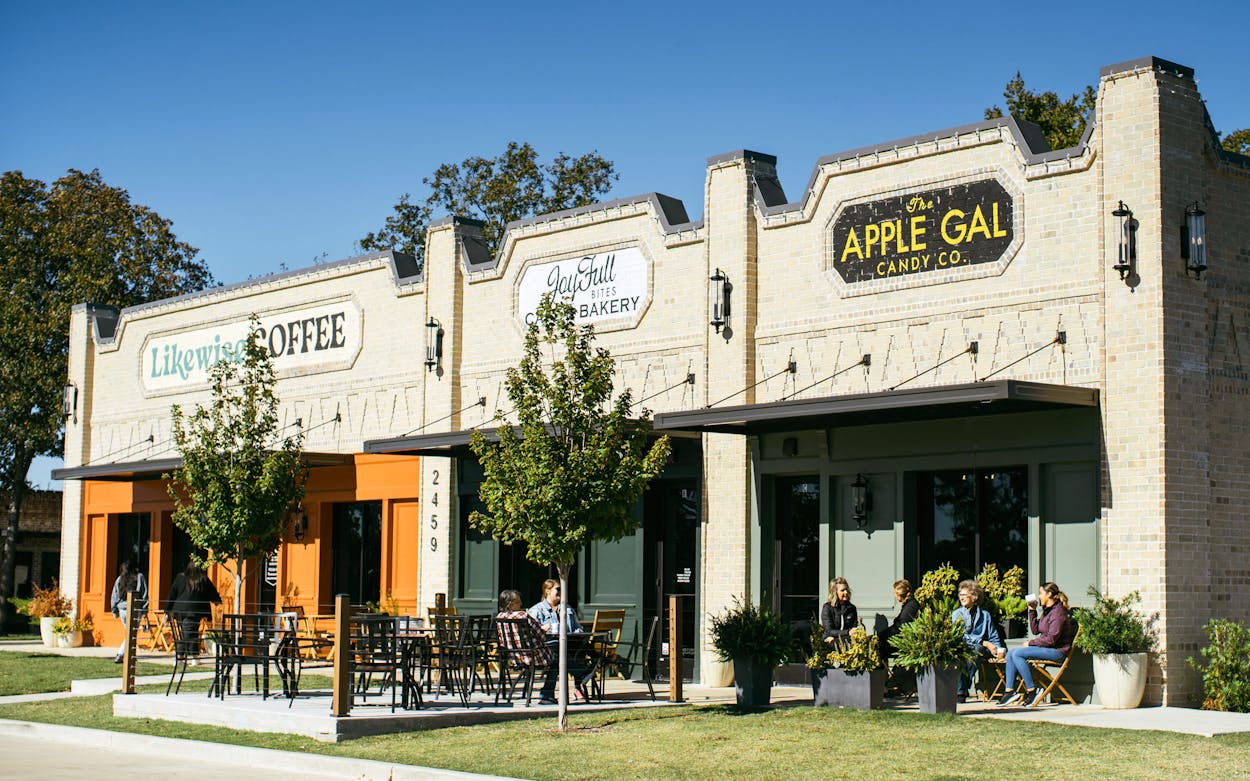In East Texas, beyond Earl Campbell Parkway, behind the surrounding forest, lies a mini utopia called the Mosaic District. Over the past seven years, a local developer has turned a forgotten Tyler neighborhood into a walkable community of historically inspired buildings that house an array of artisanal businesses.
Initially a nine-acre swath of woods sheltering an abandoned Halliburton warehouse and rail line in Tyler, the area was destined to become another big-box store before Tyler native Jim Lowden stepped in. Lowden purchased the land in 2016 with a plan to design and build a space where local businesses could thrive. Today, the area’s ten buildings compose an architectural as well as a shopping destination, and the Mosaic District is home to nineteen businesses and counting—including seven that have opened within the past six months.
“Every design starts with me and my napkin. My passion is brick design, and I’ve always been inspired by travel,” says Lowden, noting his buildings aren’t exact reconstructions but are influenced by buildings he loves and wants to “bring back.” Navigating the Mosaic District is akin to cruising through a sculpture garden of 1890-to-1920s American architectural history’s greatest hits. No two buildings are alike: Elements of Brooklyn’s iconic brownstones and Chicago’s art deco buildings appear amidst vibrant Victorian-inspired storefronts; other structures are designed in the Romanesque Revival style visible in many small-town mercantiles across Texas and Oklahoma.
“Several buildings are true to the framing of that era,” Lowden says. “It’s called balloon framing,” a technique involving long two-by-sixes in the exterior walls that extend uninterrupted from the structure’s foundation to the roof. “There’s plenty of reasons why people don’t do them anymore, especially when lumber prices went out the roof. But I’ve always tried to do what someone else isn’t doing.”
A long-time patron and partner in True Vine, Tyler’s first brewery, Lowden first showed the land to Ryan and Traci Dixon, True Vine’s founders, as a potential new home for their rapidly expanding business. Moving from a small warehouse in downtown Tyler into a larger space with room to create a backyard feel was an easy yes for the couple and the first seed of the Mosaic District to take root. Within a few months, Lowden and his construction team converted the old Halliburton warehouse and loading station into a true destination, with a brewery, taproom, dog park, playground, live music pavilion, and the addition of a gourmet brick-oven pizza and pastry business called Sola Bread next door. Seven years later, True Vine, one of only two industrial-style metal buildings in the district, is still the business at the heart of Mosaic and the beacon that has steadily drawn all others in.
“Knowing our property backed up to Earl Campell, [we thought], ‘we can turn this into some kind of community,’ ” Lowden says. Initially, he wanted to build dual-purpose buildings with residential space up top and art-based businesses below. “I wanted to build a community for artists, one hundred percent,” Lowden says. He was met with resistance from the city’s Economic Development Council, who he says sought “bigger businesses” at the time. Even without the residential option, Lowden has created a tight-knit community of diverse creatives.
Now, a wide variety of patrons fill the brick buildings of the Mosaic District Monday through Saturday. They come from near and far to shop in the old mercantile-style building, modeled after Fort Worth’s Stockyards Hotel, that houses Likewise Coffee; JoyFull Bites, a gluten-free & vegan-friendly bakery; and the Apple Gal, a shop specializing in gourmet caramel apples. Next door, under the purple awning of a stand-alone Victorian shop, is Tuesday Takeout. Lemon Yellow Latin Bites occupies a sleek brick building up the way. There’s also Foster, a hand-painted paper goods store, Strand Studio hair salon, and the Relax Lab, a spa.
Ben Casey, one of the owners of Likewise, says that the architecture and design of the area contributes to his business’s success. “People eat with their eyes, and people are doing that before they even walk in. The whole area has such a beautiful look to it,” he says. Jeff Clement, owner and lead instructor at Adjusting Sails Dirtworks, agrees: “One of the first comments [people] make is how each of the buildings is unique. It kind of takes you to a different place. So many people talk about this being a little hidden gem.”
The Claremore, a photography studio and wedding venue at the front end of the district, is housed in a two-story white structure modeled after a historic building in downtown Hutto. Lowden built it true to the way brick was laid in the late 1800s, using English bonding, but with a sleek, minimalist interior with giant pocket doors. Owners Ryan and Tara Smith sell it to engaged couples as a combination of vintage charm and modern versatility. “It’s totally different from anything around here,” says Ryan.
Though new businesses may still move into existing structures, Lowden tells me that he’s done all the major building that the area’s land can hold. The architecture component of the project is complete, but his community-building goals will live on. According to Lowden, “West Tyler is the future.”
- More About:
- Style & Design
- Architecture
- Tyler






